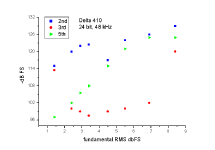Starting point for this test was a seeming discrepancy in harmonic distortion results between Arta 1.3.0 and RMAA 6.0.5.
To cut things short, the Delta410's distortion spectrum in loopback 48 kHz, 24 bit tests varies wildly with signal level. When Arta and RMAA are set to approximately the same signal level, the results agree. Arta can set the playback level from within the software, whereas RMAA relies solely on the soundcard's mixer panel. Also Arta displays the fundamental's level as RMS dbFS, whereas the RMAA level meter shows a "recorded level" without saying what this really is. With Arta output set to 0 dB and using the same mixer settings for both programs, RMAA seems to display about 2 dB more, so it is not really an RMS vs. peak issue.
First thing I did was to check various options within Arta. Whether the output and input devices where set as "Delta multi" or as the actual stereo pairs did not make any difference. Routing the output in the Delta patchbay directly to "wave out 1/2" instead of monitor mixer did not make any difference except to disable the output level control within the Delta panel. Neither did it make any difference whether a particular output level was set through the Arta signal generator setup, the Delta mixer input or master mixer. Changing the FFT length within the Arta spectrum analyzer from 16 k to 132 did nothing to the magnitude of the harmonics, it just resulted in an about 10 dB lower noise floor.
Ok, and here's the results:
- on the horizontal axis the level of the 1 kHz fundamental is given, and the fundamental was varied over a 7 dB range for these experiments
- on the vertical axis you can see the level of the 2nd, 3rd and 5th harmonics relative to full scale (all other harmonics were at -125 dB or below and disappered in the noise floor most of the time)
- as the fundamental is increased 7 dB, the 2nd harmonic increases 14 db - nothing surprising here, it just indicates you would not use the card at or near full scale if you are comfortable with the noise
- over the same range of the fundamental, the 5th harmonic increases 27 dB - this is expected, as a 5th harmonic is associated with a stronger nonlinearity
- however, the 3rd harmonic shows a sharper increase than the 5th for the initial 1 - 2 dB of signal level, then shows a very shallow increase for the next 3 dB only to improve markedly on the final 2 dB - this is very surprising, and the only handwaiving answer I could come up with is that somehow nonlinear effects in the DAC and ADC are compensating each other for part of the range
To cut things short, the Delta410's distortion spectrum in loopback 48 kHz, 24 bit tests varies wildly with signal level. When Arta and RMAA are set to approximately the same signal level, the results agree. Arta can set the playback level from within the software, whereas RMAA relies solely on the soundcard's mixer panel. Also Arta displays the fundamental's level as RMS dbFS, whereas the RMAA level meter shows a "recorded level" without saying what this really is. With Arta output set to 0 dB and using the same mixer settings for both programs, RMAA seems to display about 2 dB more, so it is not really an RMS vs. peak issue.
First thing I did was to check various options within Arta. Whether the output and input devices where set as "Delta multi" or as the actual stereo pairs did not make any difference. Routing the output in the Delta patchbay directly to "wave out 1/2" instead of monitor mixer did not make any difference except to disable the output level control within the Delta panel. Neither did it make any difference whether a particular output level was set through the Arta signal generator setup, the Delta mixer input or master mixer. Changing the FFT length within the Arta spectrum analyzer from 16 k to 132 did nothing to the magnitude of the harmonics, it just resulted in an about 10 dB lower noise floor.
Ok, and here's the results:
- on the horizontal axis the level of the 1 kHz fundamental is given, and the fundamental was varied over a 7 dB range for these experiments
- on the vertical axis you can see the level of the 2nd, 3rd and 5th harmonics relative to full scale (all other harmonics were at -125 dB or below and disappered in the noise floor most of the time)
- as the fundamental is increased 7 dB, the 2nd harmonic increases 14 db - nothing surprising here, it just indicates you would not use the card at or near full scale if you are comfortable with the noise
- over the same range of the fundamental, the 5th harmonic increases 27 dB - this is expected, as a 5th harmonic is associated with a stronger nonlinearity
- however, the 3rd harmonic shows a sharper increase than the 5th for the initial 1 - 2 dB of signal level, then shows a very shallow increase for the next 3 dB only to improve markedly on the final 2 dB - this is very surprising, and the only handwaiving answer I could come up with is that somehow nonlinear effects in the DAC and ADC are compensating each other for part of the range
